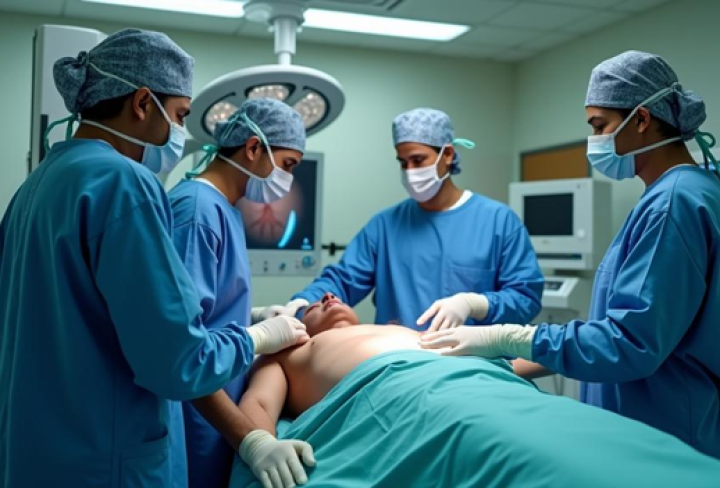Thoracoscopy is a procedure that shows doctors inside the chest area. They use a small camera without needing to make large incisions. This technique offers less discomfort and quicker healing times for patients.
In today’s medical world, thoracoscopy plays a vital role. It makes diagnosing and treating lung issues more convenient for specialists. Through the benefits of thoracoscopy, those with lung conditions find relief with greater ease. Procedures possible with thoracoscopy today were difficult before.
This blog dives deep into what thoracoscopy involves. You’ll learn how the process works and its value in lung health care. The blog covers the procedure, thoracoscopy benefits, and aspects of patient recovery. By the end, you will gain a sound understanding of this beneficial treatment.
Introduction to Thoracoscopy
Thoracoscopy, often called Video-Assisted Thoracic Surgery (VATS), lets doctors see your chest area using a camera. They make several tiny cuts to put in the camera, which helps them view your lungs on a screen to find issues. This method is safer with less stress compared to traditional methods. Minimally invasive thoracoscopy provides simplicity and effectiveness for both doctors and patients.
Over recent years, surgery has improved significantly due to technology. Minimally invasive thoracoscopy represents a big step forward in medical procedures. It enables doctors to work precisely, making operations quicker and easier. Patients gain by having smaller cuts and shorter hospital stays.
Knowing the difference between thoracoscopy and thoracotomy is crucial. Thoracotomy involves longer cuts in the chest to access the lungs, which was the older technique. On the other hand, thoracoscopy requires smaller cuts and brings less discomfort. Consequently, patients enjoy faster recovery with fewer problems.
Conditions Addressed by Thoracoscopy
Doctors use thoracoscopy to diagnose many lung conditions safely. It helps in identifying issues like pneumonia and pleurisy clearly. This method assists in uncovering causes behind unexplained chest pain.
Special procedures utilize thoracoscopy for focused lung treatments effectively. A thoracoscopy lobectomy removes a lung lobe when needed. It treats cases involving cancer or tumors efficiently. Meanwhile, thoracoscopy wedge resection removes small diseased lung parts.
Thoracoscopy performs biopsies to find serious conditions confidently. It guides doctors safely to diagnose cancer through careful observation. Early detection through this method aids in successful treatments significantly.
Advantages of Thoracoscopy Over Traditional Methods
Thoracoscopy is less invasive than thoracotomy. Surgery happens through small cuts, meaning patients heal faster and face fewer dangers. While thoracotomy is more intrusive, thoracoscopy benefits provide safer results for many cases. Patients often prefer it due to its gentler nature.
In thoracoscopy, we see smaller cuts compared to open surgery. Minimally invasive thoracoscopy offers many attractive benefits. Patients endure less pain, scarring is minor, and recovery is quicker. The reduced blood loss also contributes to the speedier healing process helping many.
Doctors notice that thoracoscopy helps save money for hospitals and patients. Shorter hospital stays mean less medical expense burden. Patients return to their usual activities quicker than with traditional procedures. These thoracoscopy cost benefits make it an appealing option for numerous families.
Innovations in Thoracoscopy: Robotic-Assisted Techniques
Robotic assistance is new in the world of thoracoscopy procedures. Robotic-assisted thoracoscopy lets surgeons perform tasks with great precision. The robots aid with vision and make movements steadier. This innovation makes the surgeries much safer and more effective.
Using robotic thoracoscopy provides surgeons with greater control over their actions. The technology gives clearer images, helping with precise surgery tasks. Robots handle specific duties, reducing errors, ensuring better patient care. These tools help achieve top results with improved outcomes for those involved.
The role of robotic technology offers great benefits in surgical success rates. Procedures are completed with high accuracy, improving patient safety levels. Robots ensure faster operations while facing fewer complications along the way. This leads to content patients and shorter recovery or hospital stays for everyone.
Recovery and Post-Thoracoscopy Care
Recovery after a thoracoscopy is quicker than traditional surgery recovery. Typically, patients can exit the hospital in one to three days. Back home, you can usually get back to normal activities within a week. It’s really important to follow your doctor’s advice closely for your specific situation.
Helpful steps for a good recovery include:
- Breathing Exercises: These help your lungs get back to normal.
- Pain Management: Use medicines given to keep pain under control.
- Activity Levels: Slowly raise activity but avoid lifting heavy things.
- Follow-Up Appointments: Attend all meetings with your healthcare provider.
These actions aid recovery while reducing issues after surgery.
Recovery from thoracoscopy often goes well, yet complications like infections or bleeding might happen. Such problems occur less often than with open surgeries, improving satisfaction among patients. Many notice less pain and faster recovery times, showing the benefits of minimally invasive thoracoscopy.
Conclusion: The Future of Thoracoscopy in Lung Treatments
Thoracoscopy benefits make it a valuable tool for treating lung issues. It offers reduced recovery times and fewer complications, making it favorable. The use of robotic assisted thoracoscopy further enhances surgery precision, suggesting promising future advancements.
As awareness grows, more patients can take advantage of thoracoscopy’s cost benefits and efficiency. Understanding the differences between thoracoscopy and thoracotomy is crucial for informed lung care decisions.
Patients should explore their options and discuss thoracoscopy in pulmonology with their doctors. Being informed about this procedure supports them in choosing wisely regarding their lung health.

